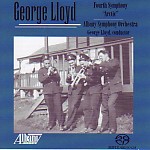George Lloyd’s Fourth Symphony was written, bit by bit, as the composer was recovering from injuries suffered in naval combat during World War II. Having witnessed the deaths in a torpedo attack of 17 of his closest comrades while at the same time almost drowning in machine oil, he was both mentally and physically destroyed, and came as close to death as makes no difference. He was gradually nursed back to health by his devoted wife, Nancy. Lloyd was unable to speak for nearly a year, and as he regained his muscular coordination he slowly returned to composing. The resultant symphony, nicknamed “The Arctic” in memory of his period of service in the North Sea, reveals none of the horror of that time, but rather, as Lloyd put it, “a world of darkness, storms, strange colors, and a far away peacefulness.”
The very act of writing this lovely, tuneful, and brilliantly scored symphony was in itself heroic. That it had to wait 35 years for its first performance is nothing short of scandalous. It’s a sure sign of how screwed up the 20th century performing arts mafia was that a composer such as Lloyd, who surely would have been ranked with Elgar and Bax had he been writing at the start of that century, was totally ignored in the ’40s, ’50s, and ’60s, merely because he stubbornly stuck to a musical language based on melody and, as a consequence, tonality (for one without the other is meaningless). He also harbored some justifiable bitterness at the fact that composers such as Britten and Tippett, who avoided military service, were later lauded (and rewarded) for their pacifist views, while those who fought and suffered for their country were treated with disdain by fellow artists who arrogantly thought themselves above the messy reality of war.
With four large movements lasting about 65 minutes, this is the first great symphony of Lloyd’s “middle period”. Aside from embodying the moods suggested by the composer’s own description, it contains in its third movement the most delicious and balletic scherzo this side of Berlioz, and it concludes optimistically with a finale chock-full of irresistible march tunes. If I had to point to an overall model for the two outer movements, it would be Sibelius’ Second symphony, both in terms of the music’s harmonic character as well as its handling of the orchestra, woodwinds in particular.
The performance captured here, under the composer’s baton, is superb, notably clearer and more sharp-edged than Edward Downes’ otherwise worthy effort on Lyrita (although we’ll have to see how that sounds on CD, coming soon). The SACD stereo remastering also is wholly successful–but however you choose to listen, do listen to this intensely beautiful, atmospheric, and joyous work. [9/6/2006]
































